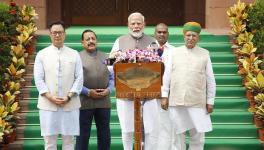Why the Rush for Privatisation of Airports?
Image for representational use only.Image Courtesy : The Hindu
Days before the end of his term as Chairman of the Airports Authority of India, senior bureaucrat Guruprasad Mohapatra laid bare the government’s plans to privatise 20-25 airports in the second phase of disinvestment, after having sold off six major ones to the private sector. The government had last year decided to privatise airports in Lucknow, Ahmedabad, Jaipur, Mangaluru, Thiruvananthapuram, and Guwahati for operation, management and development through public-private partnership (PPP) model. In February this year, the Adani Group bagged the contracts for five of these six airports.
All of these airports, so far run by the government-owned Airports Authority of India (AAI), are among the profitable ones. (As per official figures, 109 out of 123 airports in India are suffering losses.) Mohapatra told a press briefing at the AAI headquarters here last week that “we have privatised six airports; we are now planning to privatise 20-25 airports in next phase". These are “major airports with the annual passenger traffic (ranging) between 1 and 1.5 million."
The statement of Mohapatra, a Gujarat cadre officer who has been appointed as Secretary, Department of Industry and Internal Trade in the Ministry of Commerce from August 1, reflects the government ‘s rush for seeking to develop aviation infrastructure through PPPs, on the alibi of a rapid rise in air traffic. The rise in passenger traffic so far has actually been witnessed on major trunk routes and not across India.
Mohapatra’s statement also reflected the path laid out by government think-tank NITI Aayog’s ‘Strategy for New India @75’, which says that the “Way Forward” in the civil aviation sector, among other things, is to “complete the planned airports under the UDAN initiative in a time-bound manner” and to complete the “revival of 50 un-served and under-served airports/airstrips” by 2022. It also recommends completion of two new airports for Delhi and Mumbai (ie. Jhevar and Navi Mumbai) by then.
In a related development about a fortnight ago, the government amended the Airports Economic Regulatory Authority of India (Amendment) Act of 2008, wherein all such airports which the (private) operators got on long lease, based on predetermined fees, will be out of the purview of the public sector Mini-Ratna AAI. The Opposition parties and trade unions opposed the move, with the Congress saying this would mean that “all 5 airports handed over to the Adani Group, will have virtually no government control for the next 50 years."
The question that arises is whether the construction/development of an airport can be done under the same principles as those meant for the real estate sector. It cannot. While there can be a lot of scope for private parties to benefit from the non-aeronautical side of an airport, the critical infrastructural issues are on the aeronautical side -- ranging from the length, strength and direction of a runway to the height of an ATC tower to parking bays and taxiways, provision for fuel supply, storage and minimum (if not full-fledged) engineering/technical facilities etc. Under the present circumstances, these aeronautical facilities are to be built by the state-owned AAI, which will invest its own resources to build or refurbish these airports.
One of the most crucial factors in airport development is financial, especially from an airline’s point of view. The airline companies have to consider whether the route(s) out of a certain new airport will make sense in terms of economic viability, recovering costs with some profit margin, the price of fuel to be delivered there (fuel is taxed by both the Centre and the states), the demand for flights from and to that place and hence, how should the ticket be priced etc. These are issues only the airlines have to factor in while deciding on whether or not to launch flights from there.
Were the concerns of the airlines taken into account? Apparently not. The decisions seemed to be presented to the airlines as a fait accompli. Clearly, it is only when an airline starts flying into and out of a new airport can commercial activities (shopping malls, hotels) begin and flourish. Aviation consultancy firm CAPA India recently said that "the success of UDAN (regional connectivity scheme) depends on the participation by established airlines." It is not that the government was unaware of this. In reply to a question in the Lok Sabha on July 11, Civil Aviation Minister Hardeep Singh Puri said “it is up to the airline operators to provide air services to a specific place depending on the traffic demand and commercial viability”. He also said that “no bid has been received from any airline operator for operation of flights from these airports”, all in West Bengal. This is not merely a scenario for West Bengal, but destinations in several other states have been the same. In fact, an airport modernised by AAI and inaugurated by the Prime Minister saw an airline operator for only a few days and shutting shop thereafter.
While these factors do not seem to have been taken into account, the focus has been only on developing such infrastructure through expeditious sale of land and assets to private entities, many of which do not have any experience in the field of aviation at all. Such moves, experts and officials who wish to remain anonymous feel, would not only lead to AAI losing its critical financial resources, but also turn it into a mere landowner doling out land on long lease to private business houses.
The AAI Employees Joint Forum, which has been protesting the privatisation of six profit-making airports, last month shot off a letter to the Civil Aviation Minister. It referred to the previously privatised airports of Delhi and Mumbai, saying their privatisation has not brought about any good to the country or the people at large, insofar as infrastructural facilities or generating employment are concerned. Moreover, privatisation has encouraged monopolistic operation, exploitation of employees and putting additional burden on the general public, the AAI letter said.
A leaf has to be taken out of the global experiences on airport development. To take the example of the United States, which is the single largest aviation market in the world, the airports are in public hands. They are owned either by the state, local governments, municipalities or even universities. According to global statistics portal, Statista, in 2016, there were about 5,136 public-use airports in the US. All airports for public use are owned by the state or its agencies or utilities, though some may have contracted with private firms to manage airport operations or provide specific services. But the ownership has remained in the hands of the state or its agencies. The US Congress had enacted an Airport Privatisation Pilot Program way back in 1996 which had miserably failed to take off. The Trump Administration's 2018 bid to privatise airports and air traffic control has also lacked support from a large majority.
All major airports in India's neighbourhood, which attract a substantial number of Indian travellers, are owned by the respective governments or government-controlled entities or civil aviation authorities. These include the lavish airports at Singapore, Kuala Lumpur, Bangkok, Dubai, Doha, Sharjah, Muscat or Istanbul. Major stakes in one of the largest airport operators, Fraport (which runs Frankfurt Airport and several others across the world), are held by the German State of Hesse. It is imperative that the government keeps these facts in mind before going in for outright sale of such critical and valuable assets for short-term cash gains or injection into its treasury. Otherwise, its ambitious plans to make the commoner fly may just crash-land.
The writer was Deputy Executive Editor of news agency, Press Trust of India, till last year, and has extensively covered civil aviation and defence. The views are personal.
Get the latest reports & analysis with people's perspective on Protests, movements & deep analytical videos, discussions of the current affairs in your Telegram app. Subscribe to NewsClick's Telegram channel & get Real-Time updates on stories, as they get published on our website.
























